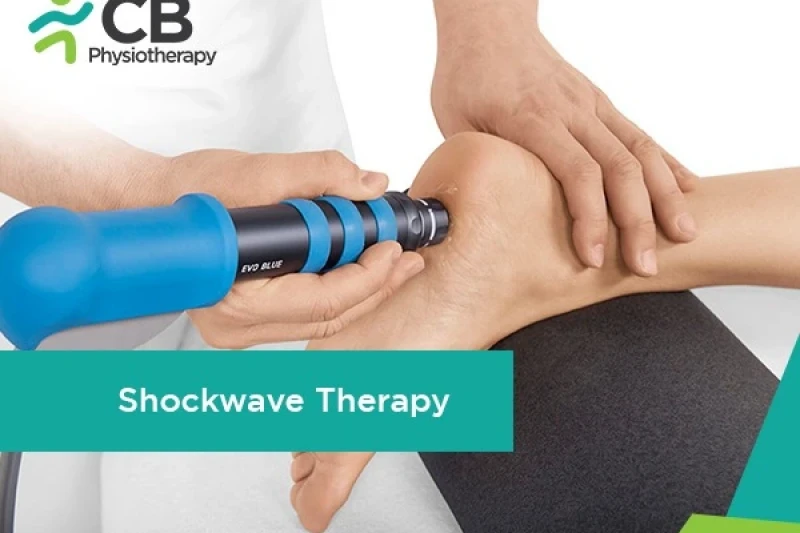
शॉकवेव थेरेपी एक गैर-इनवेसिव उपचार है जो ऊतकों में ध्वनि तरंगों को प्रसारित करने के लिए कम ऊर्जा ध्वनिक तरंग और एक युग्मन माध्यम का उपयोग करता है। इलाज के लिए। ये ध्वनि तरंगें एक उपचारात्मक प्रभाव उत्पन्न करती हैं जिससे दर्द में कमी आती है और इस प्रकार शरीर की उपचार प्रक्रिया को ट्रिगर करके गतिशीलता और कार्यक्षमता बढ़ती है। कई मस्कुलोस्केलेटल स्थितियों का इलाज करते समय इस पद्धति का अधिक उपयोग किया जाता है, जिसमें संयोजी ऊतक जैसे कि स्नायुबंधन और टेंडन शामिल होते हैं।
शॉक वेव थेरेपी के कई जैविक लाभ हैं जिनमें शामिल हैं:
  ;
· यह तीव्र और पुराने दर्द के इलाज के लिए एक गैर-इनवेसिव तरीका है
· इलाज के लिए एनेस्थीसिया की जरूरत नहीं होती
· दर्द कम करता है
· गतिशीलता बढ़ाता है
· इसके सीमित दुष्प्रभाव हैं
· यह आमतौर पर मस्कुलोस्केलेटल स्थितियों के उपचार के लिए उपयोग किया जाता है।
· शॉकवेव चिकित्सा लागत प्रभावी है
· इलेक्ट्रोहाईड्रॉलिक जनरेशन सिद्धांत
पैरामीटर्स में एकॉस्टिक एनर्जी, एनर्जी फ्लक्स डेंसिटी (EFD), दबाव वितरण और दूसरे फोकल पॉइंट पर कुल एनर्जी शामिल है . मांसपेशियों के ट्रिगर बिंदु के उपचार के लिए उपयोग की जाने वाली फोकस्ड शॉक वेव का एनर्जी फ्लक्स डेंसिटी (EFD) 0.05 और 0.25 mJ/mm2 के बीच है। ऊतक क्षति से बचने के लिए ट्रिगर बिंदु पर लागू आघात तरंग आवृत्ति 4 हर्ट्ज से अधिक नहीं होनी चाहिए। मांसपेशियों की मोटाई और गहराई के आधार पर, ऊर्जा प्रवाह घनत्व (mJ/mm2) का चयन किया जाता है। ऊर्जा प्रवाह घनत्व को इस तरह से चुना जाना चाहिए कि सदमे की लहरों से प्रेरित दर्द रोगी के लिए सहनीय हो। रेडियल शॉक वेव्स के लिए भी यही तरीका लागू होता है। हेमटॉमस से बचने के लिए, छोटी सतह वाले छोटे सरफेस शॉक ट्रांसमीटर का उपयोग करते समय अत्यधिक सावधानी बरतनी चाहिए क्योंकि वे उच्च शिखर दबाव उत्पन्न करते हैं। शॉक वेव फ्रीक्वेंसी 10 से 15 हर्ट्ज है, 15 हर्ट्ज फ्रीक्वेंसी आमतौर पर कम दर्द का कारण बनती है। ट्रिगर प्वाइंट थेरेपी में फोकस्ड और रेडियल शॉक वेव्स के संयोजन का उपयोग करते समय, ट्रिगर पॉइंट्स को पहले 200 से 400 फोकस्ड शॉक वेव्स लगाकर इलाज किया जाता है। इसके बाद रेडियल शॉक वेव ट्रांसमीटर होता है, जो 3000 से 4000 रेडियल शॉक वेव्स लगाता है।
आवृत्ति: अधिकांश रोगियों के लिए प्रति सप्ताह एक सत्र देना आदर्श है। ये अंतराल मांसपेशियों को जलन से उबरने का समय देते हैं, जिसे रोगी तीन दिनों तक महसूस कर सकता है।
शॉकवेव चिकित्सा में सकारात्मक और नकारात्मक चरण होते हैं। सकारात्मक चरण प्रत्यक्ष यांत्रिक बल उत्पन्न करता है, जबकि नकारात्मक चरण गुहिकायन और गैस के बुलबुले उत्पन्न करता है जो बाद में उच्च गति पर फट जाता है, जिससे शॉकवेव की दूसरी लहर उत्पन्न होती है। यह कम आयाम, छोटी अवधि और कम वृद्धि समय के बाद उच्च शिखर दबाव का उपयोग करता है। उनके पास उच्च दबाव आयाम (0-120 एमपीए) और एक विस्तृत आवृत्ति रेंज (0-20 मेगाहर्ट्ज) के साथ एक एकल नाड़ी है। जबकि अल्ट्रासाउंड तरंगों में शॉकवेव की तुलना में लगभग 1000 गुना कम पीक प्रेशर होता है। शॉकवेव्स कम आवृत्ति की दबाव की गड़बड़ी हैं जो तीन आयामी अंतरिक्ष में तेजी से यात्रा करती हैं, जो परिवेश के दबाव से उनके अधिकतम दबाव में अचानक वृद्धि से जुड़ी होती हैं। महत्वपूर्ण ऊतक प्रभावों में गुहिकायन शामिल हैं, जो तरंग प्रसार के नकारात्मक चरण के परिणामस्वरूप होते हैं।
पूरी प्रक्रिया किसी भी थर्मल प्रभाव का उत्पादन नहीं करती है, यह पुनरोद्धार को बढ़ावा देती है, प्रसार और ऑस्टियोप्रोजेनिटर भेदभाव को उत्तेजित करती है, ल्यूकोसाइट घुसपैठ को बढ़ाती है, कोलेजन संश्लेषण और ऊतक रीमॉडेलिंग को प्रोत्साहित करने के लिए विकास कारक और प्रोटीन संश्लेषण को बढ़ाता है।
आवेदन
रोगी फिजियोथेरेपिस्ट द्वारा उसकी पहली यात्रा के दौरान यह पुष्टि करने के लिए मूल्यांकन किया जाता है कि वह शॉकवेव थेरेपी के लिए उपयुक्त उम्मीदवार है। उपचार क्षेत्र पर जेल लगाने से उपचार शुरू हो जाता है। ऐप्लिकेटर या थेरेपी हेड को सीधे उस जगह पर रखा जाता है। रोगी की त्वचा के माध्यम से तरंगों के संचरण के लिए जेल के माध्यम की आवश्यकता होती है। पैरामीटर सेट किए गए हैं और रोगी के आराम के अनुसार तीव्रता लागू की जाती है (मस्कुलोस्केलेटल स्थितियों के उपचार के लिए कोई मानकीकृत प्रोटोकॉल नहीं है)। इसका उपयोग उपचार-विशिष्ट अभ्यास, गतिविधि संशोधन के संयोजन के साथ किया जा सकता है। परिणामों के आधार पर, रोगी को 3-6 सप्ताह के लिए सप्ताह में एक बार शॉकवेव थेरेपी लेने की सलाह दी जाती है।
शॉकवेव थेरेपी का उपयोग सामान्य मस्कुलोस्केलेटल स्थितियों के उपचार में सबसे अधिक किया जाता है। इनमें शामिल हैं:
· सरवाइकल और लम्बर स्पाइन क्षेत्रों में तीव्र और जीर्ण मांसपेशियों में दर्द।
· क्रोनिक टेंडिनोपैथी
· रोटेटर कफ की मांसपेशियों का कैल्सीफिक टेंडिनोसिस
· पीठ का दर्द
· गोल्फर्स एल्बो
· टेन्सर फेशिया लेट सिंड्रोम
· इलिओटिबियल बैंड फ्रिक्शन सिंड्रोम
· ग्रेटर ट्रोकेनटेरिक पेन सिंड्रोम
· ऊरु सिर का अवास्कुलर नेक्रोसिस
· मेडियल टिबियल स्ट्रेस सिंड्रोम
>· -खिंचाव: सामान्य; रेखा-ऊंचाई: सामान्य;"> Patellar tendonitis
· जम्पर का घुटना
· बर्साइटिस
· Metarsalgia
· टिबियलिस एंटीरियर सिंड्रोम
· अकिलिस टेंडोनाइटिस
· एड़ी में खिंचाव
· फ्रैक्चर
· छोटे जोड़ों का एक्सोस्टोसिस
· दोहरावदार तनाव और अत्यधिक उपयोग की चोटें।
उपचार के बाद कुछ दिनों के लिए मरीज को अस्थायी कोमलता, खराश या सूजन का अनुभव होता है, शॉकवेव्स एक भड़काऊ प्रतिक्रिया को उत्तेजित करती हैं। उपचार पूरा होने के तुरंत बाद रोगी नियमित गतिविधियों पर लौट आता है।
· पेसमेकर
· प्रत्यारोपित उपकरण
· संयुक्त प्रतिस्थापन
· गर्भावस्था
· ट्यूमर
· संक्रमण
· खुले घाव
· परिसंचरण या तंत्रिका विकार।
फिजियोथेरेपी के बारे में हमारे विशेषज्ञों को खोजने और उनसे जुड़ने के लिए अपने शहर का चयन करें शॉकवेव थेरेपी